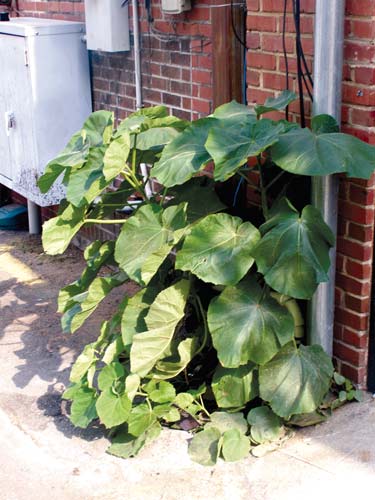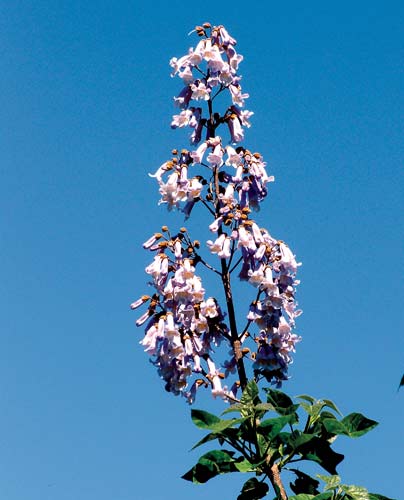A big-leaved threat
Originally published August 7, 2008

Non-native Paulownia can grow anywhere! Photo by Ken Moore
by Ken Moore
I’m always impressed by those large round leafy stems that seem to have grown six to 12 feet overnight along roadside banks and ditches. This fast-growing plant is promoted by the nursery industry as a miracle tree, the fastest growing one in America. For the homeowner, this exotic (non-native) royal paulownia, royal empress or princess tree, Paulownia tomentosa, is an easy sell.
This tree is more noticeable in the urban landscape, where vigorous clumps thrive in sidewalk cracks, edges of building foundations, on rooftops and even on fire escapes. In spite of eradication efforts, several impressive clumps persist behind a popular West Franklin Street watering hole. One of the many survival characteristics of this tree is rapid recovery following drastic pruning.

Don’t succumb to the beauty of paulownia flowers in the spring. Photo by Ken Moore
Make certain you don’t confuse paulownia with the native catalpa, of which mature specimens and sidewalk seedlings occur in and around Carrboro (see Flora in the May 15, 2008 issue of The Carrboro Citizen). I always have to take a closer look at the similarly shaped leaves to distinguish these two trees. Paulownia leaves are fuzzy, almost velvety, to the touch and occur in opposite pairs along the stem. In contrast, the less fuzzy catalpa leaves occur in threes at the nodes along the stem. There is no doubt about the identity of a mature paulownia when you observe the fruit: upright clusters of round capsules, unlike the long, thin, beanpod-like fruit hanging on a mature catalpa.
You’ve most likely noticed paulownia’s vertical clusters of pale purple flowers in the early spring. Looking like a tree foxglove, it is the only tree species in the Scrophulariaceae (foxglove or figwort family) to occur in North Carolina.
You will either cherish or disdain the tree. It is listed as an unwanted exotic invasive by the N.C. Botanical Garden, The Nature Conservancy, USDA, US Forest Service and the National Park Service. It is a “Least Wanted Plant†of the Plant Conservation Alliance Alien Plant Working Group. Enough said!
Native to China, it was introduced to Europe by the Dutch East India Company in the 1830s. It is interesting to note that the genus name, Paulownia, honors Queen Anna Pavlovna of The Netherlands (1795-1865), daughter of Tsar Paul I of Russia, thus the common names royal empress and princess. By 1840, it was already being grown in America as a desirable ornamental. Now, in addition to promotion by the nursery industry, there is an American Paulownia Association “dedicated to the advancement of paulownia.†In China and Japan, the wood is utilized in the making of cabinets, flooring, musical instruments and even shoes. It is strong and 30 percent lighter than comparable American hardwoods and naturally rot resistant. Imagine thousands of acres of paulownia forests in North Carolina as another profit-making venture.
Paulownia is on a deadly forward march similar to another exotic, the Tree of Heaven, Ailanthus altissima, introduced to America in the late 1700s (see Flora in the July 12, 2007 issue of The Carrboro Citizen). Ailanthus is so invasive that native species have been displaced along entire forest edges. So please don’t succumb to paulownia promotions, and serve a good cause by eradicating any within your realm of control.
Our native trees are just as beautiful and far less harmful to our nature.



Comments are closed.